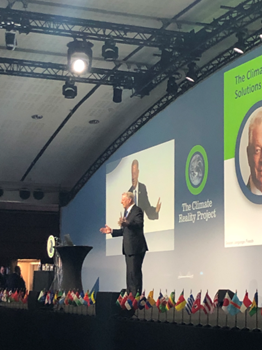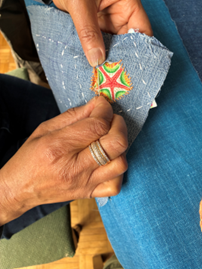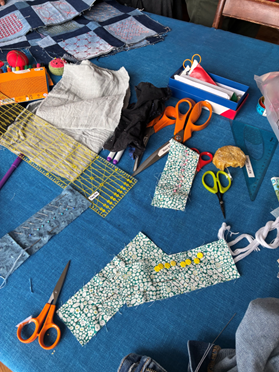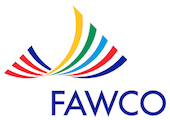by Jill Amari, AAWE Paris
 In today’s world, often filled with material goods and wasteful habits, what daily actions can we take to be protectors of the Earth? Since moving to Paris in July 2023, I’ve searched for ways to expand my environmental activism: I compost, and I teach my English students about climate change. I interned at and continue to support the urban farm and sustainable restaurant La REcyclerie in the 19th arrondissement here in Paris. Most recently, I volunteered to help relaunch our AAWE “Green Team” and, significantly, I attended the Climate Reality Leadership Corps Training here in Paris at the end of March.
In today’s world, often filled with material goods and wasteful habits, what daily actions can we take to be protectors of the Earth? Since moving to Paris in July 2023, I’ve searched for ways to expand my environmental activism: I compost, and I teach my English students about climate change. I interned at and continue to support the urban farm and sustainable restaurant La REcyclerie in the 19th arrondissement here in Paris. Most recently, I volunteered to help relaunch our AAWE “Green Team” and, significantly, I attended the Climate Reality Leadership Corps Training here in Paris at the end of March.
The Climate Reality Project is an environmental organization founded by former US Vice President Al Gore which focuses on educating people from all walks of life about the facts of climate change and giving them the information and skills they need to take action. The Project kicked off their international training tour this year in Paris, to celebrate 10 years of the Paris Agreement, which is an international treaty on climate change focused on limiting global warming and achieving net zero greenhouse gas emissions by mid-century. This three-day training marked the 58th training of the Climate Reality Leadership Corps.
Each day, along with about 800 other participants, I traveled to the Louvre, to a venue that was not only historical but also sustainable. Les Salles du Carrousel has been revamped to reduce carbon emissions as much as possible, for example, composting and recycling are always available, and water and electricity usage are continuously monitored.
What was the highlight of the training? Al Gore’s 2.5-hour, 500-slide presentation on our first day. He showed us videos and pictures of natural disasters across the world – some of which had already occurred in 2025 – and didn’t sugarcoat any of the facts regarding climate change. He mentioned that his presentation used to include evidence of natural disasters that had occurred a few years ago, compared to his current presentation which showed more recent disasters, such as the wildfires in California and Chile earlier this year.
 He also referenced the COVID-19 pandemic and explained that new infectious diseases are on the rise, with five new diseases emerging each year. Some of these are linked to tropical diseases moving to non-tropical areas, while others are related to the increase in rainfall, flooding, and warming oceans which produce toxic algae.
He also referenced the COVID-19 pandemic and explained that new infectious diseases are on the rise, with five new diseases emerging each year. Some of these are linked to tropical diseases moving to non-tropical areas, while others are related to the increase in rainfall, flooding, and warming oceans which produce toxic algae.
To make the presentation specific to Paris, he informed us that Europe is the fastest-warming continent and showed pictures of natural disasters that had occurred in France, such as the storm surges and flooding in Saint-Malo in April 2024. Furthermore, he explained that the number of climate refugees moving to northern Europe will only increase, leading to a lack of resources and more social, economic, and political issues. For example, xenophobia often festers in communities where refugees seek asylum.
Most importantly, he broke down the science of global warming in language that was easy to understand, and delivered the hard truth: we need to take action NOW. Although scientific data has evolved and climate change has worsened since the 2006 movie An Inconvenient Truth, this fundamental message has remained the same.
At the end, he discussed solutions that are already in place or that could easily be put into place. He emphasized that most of the technology we need to stop climate change from worsening already exists, and that it is possible to get to net zero greenhouse gas emissions and to start the Earth on a path to healing. However, this part of the presentation lasted only about 30 minutes out of the 2.5 hours. Needless to say, we were all eager to get some fresh air and food after that.
While the Climate Reality Team couldn’t cover everything related to climate change over three days, I felt that they did an excellent job with the time they had. One topic I wish they had discussed more was AI and its environmental impacts. I am against AI not only as a writer, but also as an environmental activist: for instance, the energy and fresh water required to power AI is vast. (You can read more about the environmental impacts of AI here.) During the training, some scientists and speakers discussed the benefits of AI; however, these benefits were large scale, such as advances in medical technology or in weather prediction for natural disasters, rather than small scale, like using ChatGPT to write college essays or come up with a recipe. I believe all citizens should be aware of AI’s inordinate use of natural resources, and I hope the Climate Reality Team discusses the environmental impacts of AI at future trainings.
Ultimately, I felt inspired and better informed by the end of the training. We heard from several local activists and organizations, including the well-known Climate FRESK, Fridays for Future France, and ChangeNOW. (I later volunteered at the ChangeNOW summit in April.) I particularly enjoyed hearing from younger activists (some as young as 18!) and from the Mayor of Paris, Anne Hidalgo, who has been a champion for renovating the city to be more sustainable. For instance, she pushed for a massive cleanup of the Seine in preparation for the 2024 Summer Olympics – and even swam in it herself. Al Gore praised her environmental activism and her efforts to make Paris greener, such as by reducing air pollution, creating more green spaces, providing benefits for people with electric cars, and making the streets more bike- and pedestrian-friendly.
It was refreshing to be around people who not only share my values, but also understand and appreciate my enthusiasm when I speak about the environment. I highly encourage anyone who has the opportunity to attend the Climate Reality Leadership Corps Training to do so. The training itself is free of charge, though attendees must pay for travel and lodging if needed. There is also an online option available for those who can’t travel to each training location. If you attend a training in person, you’ll also get a free vegetarian or vegan lunch and snacks throughout the day. This training has been designed for you – no matter if you’re a beginner or expert at environmental activism. It was intense and educational – motivating us to improve our grasp of climate science, to connect with like-minded individuals, and to take action in our homes, social lives, or places of work.
Now, a few months after the training and with AAWE’s Green Team starting to gain traction, I feel both the urgency of the current climate situation and hope for the future. Though the Green Team just relaunched in April, many people have already joined or expressed interest in volunteering. Currently, the team is focused on three topics: textile waste, overconsumption, and community gardening. Our first event was a mending workshop where we learned the Sashiko method to mend clothes, and more events are lined up.


I hope that, with the support of a team behind me and the Climate Reality training under my belt, I’ll be able to educate more people about climate change and flourish as an environmental activist.
For further information, please see The Climate Reality Leadership Training website.
All photos by the author.
This article has also been published in AAWE News.
